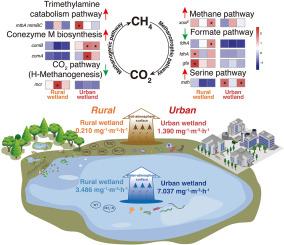Microbial mechanisms underlying differences of methane emissions between urban and rural wetlands
IF 10.3
1区 农林科学
Q1 SOIL SCIENCE
引用次数: 0
Abstract
Methane (CH4) emissions differ between urban and rural wetlands, while the microbial mechanisms associated with these differences have not been clearly identified. Here, we characterized the CH4-cycling microbial communities and their functional function metabolic pathways between urban and rural wetlands by using 16S rRNA amplicon sequencing, metagenomes and CH4 flux measurements. Results showed that rural wetlands primarily utilized acetate/CO2-dependent methanogenic pathway and complete carbon oxidation to CO2 in methanotrophic pathway. Whereas, urban wetlands were dominated by the coenzyme M-dependent methanogenic pathway and trimethylamine catabolism, with methanotrophic pathway characterized by enhanced carbon assimilation capacity. In wetland water, while the abundances of methanogens in urban water were 5-fold lower than in rural water, urban water exhibited stronger microbial cooperation and higher metabolic flexibility, which were associated with an 85% higher water-atmosphere CH4 flux compared to rural counterparts. In wetland soil, key environmental factors (e.g. higher pH and lower organic matter content compared to rural sites) shaped distinct microbial community structures and CH4 metabolic traits. These differences were shown as higher functional gene diversity, more stable co-occurrence networks, and greater metabolic flexibility, which were linked to a 6-fold higher soil CH4 emissions than in rural soil. This study describes the microbial mechanisms underlying CH4 emission differences between urban and rural wetlands, providing insights into microbially mediated CH4 cycling in urban wetland ecosystems.

城乡湿地甲烷排放差异的微生物机制
城市湿地和农村湿地的甲烷(CH4)排放存在差异,而与这些差异相关的微生物机制尚未明确。通过16S rRNA扩增子测序、宏基因组和CH4通量测量,研究了城市和农村湿地之间CH4循环微生物群落及其功能代谢途径。结果表明:农村湿地主要利用醋酸/CO2依赖的产甲烷途径和完全的碳氧化为CO2的甲烷营养途径。城市湿地以辅酶m依赖性产甲烷途径和三甲胺分解代谢为主,其中甲烷营养途径以碳同化能力增强为特征。在湿地水体中,虽然城市水体中产甲烷菌的丰度比农村水体低5倍,但城市水体表现出更强的微生物合作和更高的代谢灵活性,这与水-大气CH4通量比农村水体高85%有关。在湿地土壤中,关键环境因素(如pH值较高、有机质含量较低)塑造了不同的微生物群落结构和CH4代谢特征。这些差异表现为更高的功能基因多样性、更稳定的共生网络和更大的代谢灵活性,这与土壤CH4排放量比农村土壤高6倍有关。本研究描述了城市湿地和农村湿地CH4排放差异的微生物机制,为城市湿地生态系统中微生物介导的CH4循环提供了新的思路。
本文章由计算机程序翻译,如有差异,请以英文原文为准。
求助全文
约1分钟内获得全文
求助全文
来源期刊

Soil Biology & Biochemistry
农林科学-土壤科学
CiteScore
16.90
自引率
9.30%
发文量
312
审稿时长
49 days
期刊介绍:
Soil Biology & Biochemistry publishes original research articles of international significance focusing on biological processes in soil and their applications to soil and environmental quality. Major topics include the ecology and biochemical processes of soil organisms, their effects on the environment, and interactions with plants. The journal also welcomes state-of-the-art reviews and discussions on contemporary research in soil biology and biochemistry.
 求助内容:
求助内容: 应助结果提醒方式:
应助结果提醒方式:


